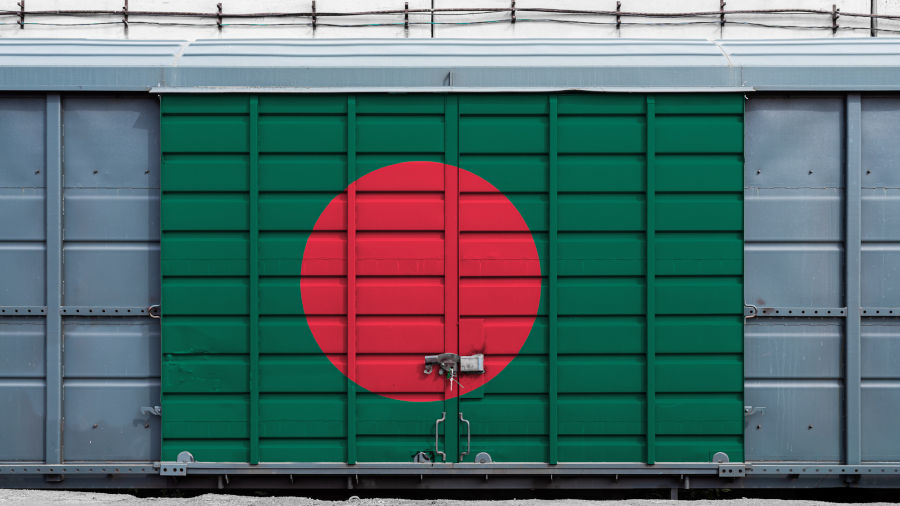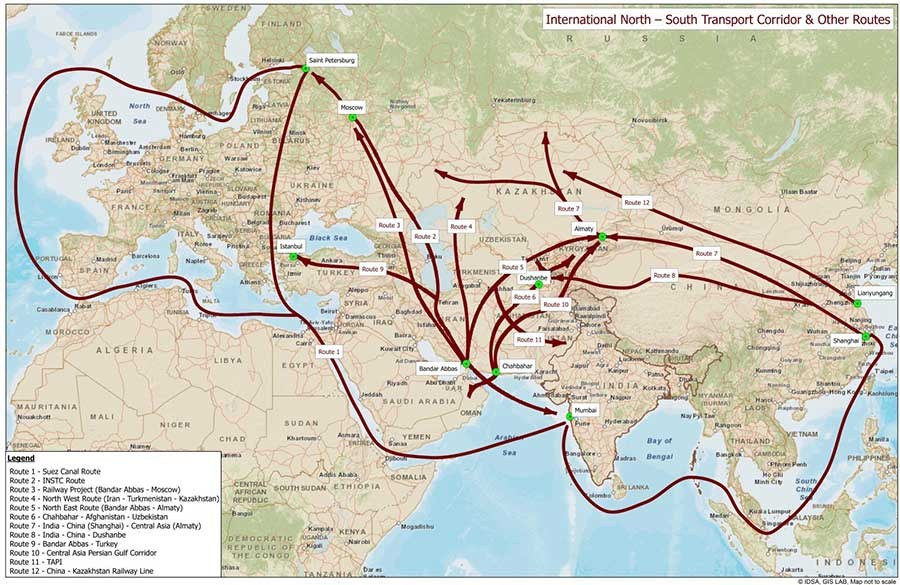The International North-South Transport Corridor: What Is The Potential For Bangladesh?

By MD Pathik Hasan
The International North-South Transport Corridor (INSTC) is a 7,200km long multi-mode transport project for moving freight between India, Iran, Afghanistan, Armenia, Russia, Belarus, Bulgaria, Kazakhstan, Kyrgyzstan, Oman, Syria, Tajikistan, Turkey, and Ukraine. It is a strategic significant connectivity project in Central Asia and Europe. It is a not a new concept, as the current INSTC project was initiated by Russia, India, and Iran in September 2000 in St. Petersburg. The agreement was signed on 16th May 2002. Now all parties specially India, Iran and Russia are working to come bring the INSTC to life.
The INSTC connects Mumbai to Moscow and passes through Iran and Azerbaijan. India is very interested to include the Iran’s Chabahar Port to facilitate such connectivity. There are huge Indian investments in Iran. India has good ties with both Armenia and Azerbaijan. The INSTC extends from Mumbai to Chabahar via Azerbaijan to Moscow, offering much potential for India’s regional connectivity plans.
According to the Indian Foreign Ministry, enhancing the connectivity of the INSTC will facilitate the transportation of goods and improve trading links between India, Russia, and Iran.
The INSTC will reduce the time and cost of delivering goods by more than 40 percent in comparison with the Suez Canal. Russian and India Foreign Ministers positively assessed the economic cooperation noting new opportunities in the Russian Far East. They spoke of connectivity including the INSTC with the Chennai-Vladivostok Maritime Corridor during Russian Foreign Minister Sergei Lavrov’s visit to India in April this year. The approach in New Delhi is to provide faster and cheaper connectivity to Beijing‘s Belt and Road Initiative.
At a connectivity conference in Tashkent in July, Indian External Affairs Minister S Jaishankar projected Iran’s Chabahar port as a key regional transit hub, including to Afghanistan, suggesting the inclusion of Chabahar port with such connectivity plans. This connectivity project will help the regional states to be connected.
India has proposed to include the Chabahar port in the framework of the INSTC and has welcomed the formation of the India-Uzbekistan-Iran-Afghanistan Working Group on the joint use of Chabahar port. A meeting of the joint group likely to be held under that framework later this year on joint use of the port.
The main objectives of the project are to revive ancient transport routes and to connect the Indian ocean to the Persian gulf and the Caspian sea. This is a shorter passage between Russia and India via Iran and Central Asian states. Consequently, this is an opportunity for Bangladesh.
There is potential for Bangladesh to utilize the INSTC connectivity. Bangladesh is a neighboring country of India, with links between Indian and Bangladeshi ports. Bangladeshi Ports can be connected with this project via the Mumbai – Chennai port and Iran’s Chabahar port. The diplomatic relations between Bangladesh and India are solid, while Chittagong port and Mongla port can be connected directly with the project for the benefit of Bangladesh trade and exports.

Connectivity is essential for every country. As a rising economic star in South Asia, Bangladesh can participate in the project for its own business interests.
The Bangladesh economy is currently booming, with renowned economists describing it as the latest South Asian economic miracle. The current ruling party, Bangladesh Awami League is trying its best to make the country socio-economically prosperous under the leadership of Premier Sheikh Hasina.
Bangladesh and Central Asia can be connected through this route. There is a huge market for Bangladeshi products. Bangladesh’s garments sector is one of the world’s largest, although it needs cotton and other materials. Bangladesh can easily import cotton from central Asian states, wheat from Russia, while seeking investment from these countries. Bangladesh can export leather, apparel and potato to the Central Asian states, Russia and China.
Bangladesh would be able to increase its exports to Iran and seek investment from Tehran through using the Chabahar port. Although Iran and Russia suffer from US sanctions, India can help Bangladesh in this regard. Bangladesh’ s target is to become a developed country. India would be a great development partner.
Asia is well aware of the Afghanistan crisis. Bangladesh can take part in the development process (Socio-economic-infrastructure) in Afghanistan if the situation is normal and stagnant. This connectivity project will pave the way.
Bangladesh would like to play a role to ensure regional stability. Its aim is to boost the economic standing of its people along all regions. Bangladesh would like to be an active partner of this development within South Asia and Eurasia.
Bangladesh Foreign Minister Dr AK Abdul Momen attended the “Central and South Asia: Regional Connectivity – Challenges and Opportunities” conference held in Tashkent in July, demonstrating the national interest.
Bangladesh may seek to sign Free Trade Agreements with Eurasian states to obtain duty free access. Combining efforts among all states to establish connectivity in Central and South Asia can open new avenues of cooperation.
Bangladesh has tried to boost connectivity with its neighboring countries and playing a leading role through the Bay of Bengal Initiative for Multi-Sectoral Technical and Economic Cooperation (BIMSTEC), and has initiated connections with Bhutan, India, Sri Lanka, Thailand, Nepal, and Myanmar and the ASEAN nations.
Bangladesh is also trying to engage in various connectivity projects through road, rail, and sea routes with the neighboring countries cooperation. In today’s world, there is no alternative other than connectivity with other states. A new aspiration is for Bangladesh to be part of this. The new potential is for Bangladesh to be connected with the INSTC.
We are grateful to Pathik Hasan for contributing this article. Dr. Hasan is a Dhaka based NGO worker, and freelance writer commenting on current affairs and international politics. He can be contacted at pathikhasan1141@gmail.com
Related Reading
About Us
Silk Road Briefing is written by Dezan Shira & Associates. The firm has 28 offices throughout Asia, and assists foreign investors into the region. For strategic advisory and business intelligence issues please contact the firm at silkroad@dezshira.com or visit www.dezshira.com





